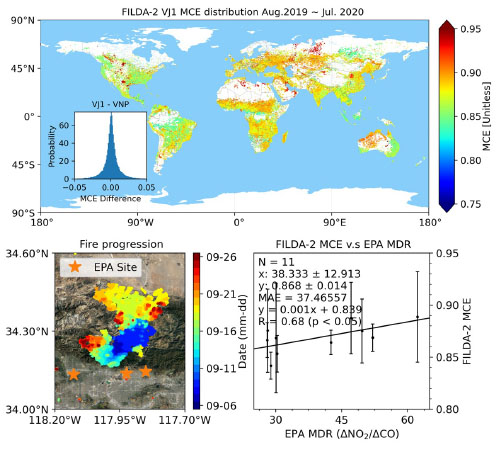NASA FIre Light Detection Algorithm (FILDA) Fire Modified Combustion Efficiency Products
Product User GuidePI - Jun Wang (UIOWA)
Co-Is: Lu Hu and Bob Yokelson (U. of Montana), Tara Yacovitch and
Scott Herndon (Aerodyne Research, Inc.), David Peterson (Naval Research Lab)
Collaborators: Zhuosen Wang (UMD/NASA GSFC), Meng Zhou (U. Iowa)
The FILDA 375m/750m fire modified combustion efficiency product integrates the day/night band (DNB), medium-wavelength infrared (MWIR), and long wavelength infrared (LWIR) channels to simultaneously improve the fire detection and retrievals of fire radiative power (FRP), fire visible energy fraction (VEF), and fire modified combustion efficiency (MCE) at nighttime from the holistic use of those multiple-spectral radiances measured by the VIIRS Suomi-NPP (VNP) and NOAA-20/JPSS-1 (VJ1) satellites.
The FILDA algorithm generates the Level 2 active fire data products at 375m (Imagery resolution bands) and 750m (Moderate resolution bands). Each data product includes the following key parameters describing the characteristics of a fire pixel: (a) its location in terms of latitude and longitude; (b) FRP; (c) VEF, (d) MCE.
Atmospheric gas absorption plays a significant role in attenuating fire radiance. Deng et al. (2024) demonstrated that neglecting this effect can result in up to a 60% underestimation of fire radiative power (FRP). In the current FILDA-2 product, FRP is derived from 4 µm radiance using Wooster’s empirical regression approach, without applying atmospheric correction. Therefore, it is recommended to perform offline atmospheric correction on FRP for improved accuracy. The Python package to conduct atmospheric correction for VIIRS FILDA FRP retrieval can be found at https://github.com/uiowa-aer-lab/frp-atmospheric-correction/tree/main. The required look-up tables can be downloaded from https://arroma.uiowa.edu/filda_luts.php.

Global distribution of MCE retrieved from NOAA-20 VIIRS, averaged to a 0.25×0.25-degree climate model grid. Inset: Histogram of difference of FILDA2 MCE between NOAA-20 VIIRS (VJ1) and Suomi-NPP VIIRS (VNP).
Product Details and links to LPDAAC
| Product Name | SNPP | JPSS-1 |
|---|---|---|
| FILDA-2 Fire Modified Combustion Efficiency Product 6-min L2 Swath 750m | VNP47MOD | VJ147MOD |
| FILDA-2 Fire Modified Combustion Efficiency Product 6-min L2 Swath 375m | VNP47IMG | VJ147IMG |
References
The algorithm theoretical basis and description for FILDA can be found in the reference papers below.
Deng, W., M. Zhou, J. Wang, Z. Xue, Z. Lu, X. Chen, H. Zhang, D. A. Peterson, E. J. Hyer, and A. M. da Silva (2024), Advancing FRP Retrieval: Bridging Theory and Application, IEEE Transactions on Geoscience and Remote Sensing, 62, 1-16, doi:10.1109/TGRS.2024.3470538.
Zhou, M., J. Wang, L. Castro Garcia, X. Chen, A. da Silva, Z. Wang, M. O. Roman, E. Hyer, and S. D. Miller, Enhancement of Nighttime Fire Detection and Combustion Efficiency Characterization using Suomi-NPP and NOAA20 VIIRS Instruments, IEEE Transactions on Geoscience and Remote Sensing, vol. 61, 4402420, 2023.
Wang, J., M. Zhou, X. Xu, S. Roudini, S. Sander, T. Pongetti, S. Miller, J. Reid, E. Hyer, R. Spurr, Development of a nighttime shortwave radiative transfer model for remote sensing of nocturnal aerosols and fires from VIIRS, Remote Sensing of Environment, 241, 111727, 2020.
Wang, J., S. Roudini, E. J. Hyer, X. Xu, M. Zhou, L. Castro Garcia, J. S. Reid, D. Peterson, A. Da Silva, Detecting nighttime fire combustion phase by hybrid application of visible and infrared radiation from Suomi NPP VIIRS, Remote Sensing of Environment, 237, 111466, 2020.
Polivka, T., J. Wang, L. Ellison, E. Hyer, and C. Ichoku, Improving Nocturnal Fire Detection with the VIIRS Day-Night Band, IEEE Transactions on Geoscience & Remote Sensing, 9, 5503-5519, 2016.
Polivka, T., E. Hyer, J. Wang , and D. Peterson, First global analysis of saturation artifacts in the VIIRS infrared channels and the effects of sample aggregation, IEEE Geoscience and Remote Sensing Letters, 1262-1266, 2015.
References are available at https://esmc.uiowa.edu/filda/filda_reference.php


